
Cart
CloseNo products in the shopping cart.

No products in the shopping cart.
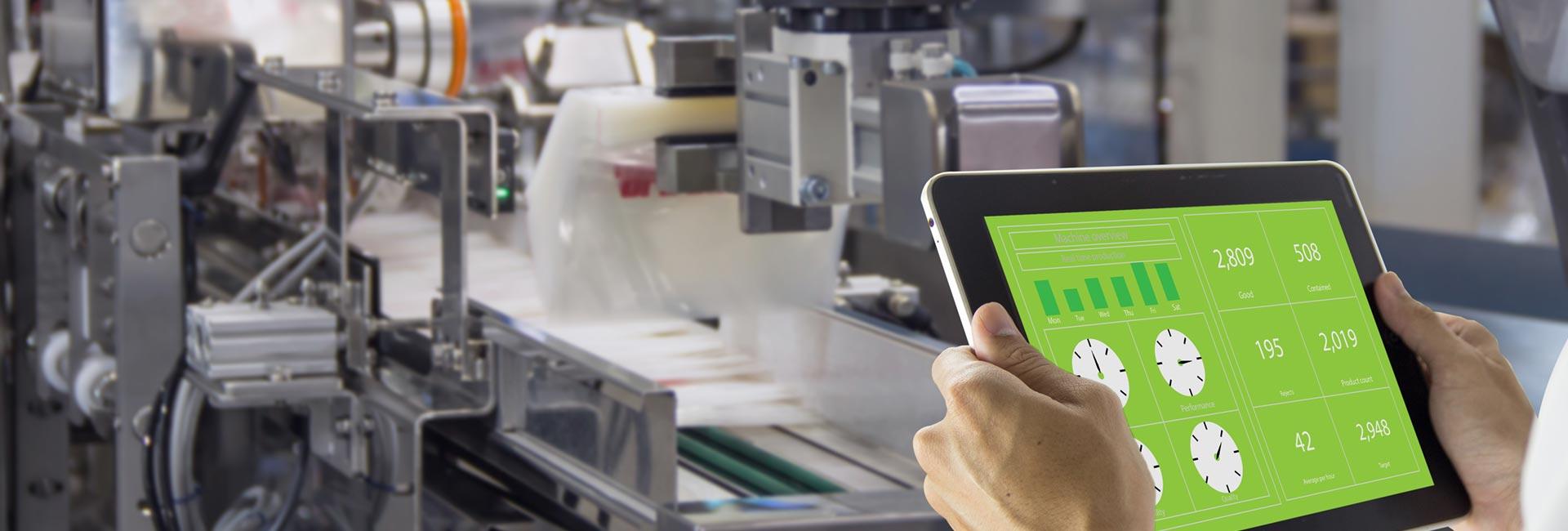
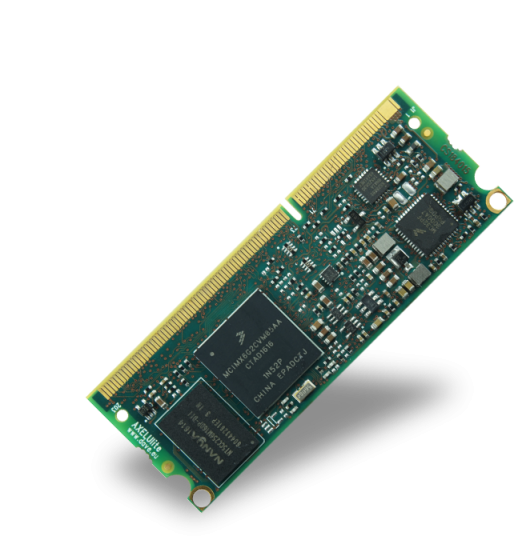

AXEL Ulite - i.MX6UL
 Processor: NXP/Freescale i.MX6 UL / i.MX6 ULL
Processor: NXP/Freescale i.MX6 UL / i.MX6 ULL
AXEL ULite is the brand new solution made by DAVE Embedded Systems, based on the recent NXP/Freescale i.MX6 Ultra Lite application processor. AXEL ULite defines a new limit in low power consumption with its ARM Cortex A7 architecture and enables customers to design a new concept of Embedded IoT devices.
AXEL ULite offers great compromise between computing and power consumption, thanks to the ARM Cortex-A7 architecture. Additionally, the use of this processor enables extensive system-level differentiation of new applications in many industry fields, where power consumption, connectivity and extremely compact form factor (67,50 mm x around 25,40 mm) are key factors. The advanced security features and the three different CPU versions available (Base, General Purpose and Security) offer a wide scenario of applications. Smarter system designs are made possible, following the trends in functionalities and interfaces of the new, state-of-the-art embedded products.
AXEL ULite is fully compatible with AXEL LITE SOM (Based on NXP i.MX6). This means that customers are enabled to build a wide portfolio of products with very different performance / power consumption and cost budgets. This is in line with DAVE Embedded Systems philosophy to support customers along with their business providing new solutions which can enlarge their gamma of products re-using as much as possible the existing HW and SW platforms.
Thanks to AXEL ULite, customers have the chance to save time and resources using a compact solution that permits to reach scalable performances that perfectly fits the application requirements avoiding complexities on the carrier board. Last but not least, AXEL ULite is suitable for high volume applications where the price/quality ratio is important such as the embedded Internet Of Things, portable solutions, gateways, solar applications.
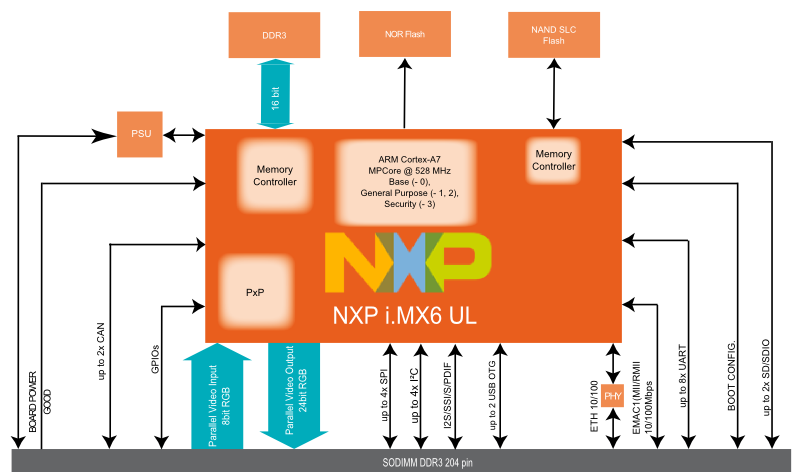
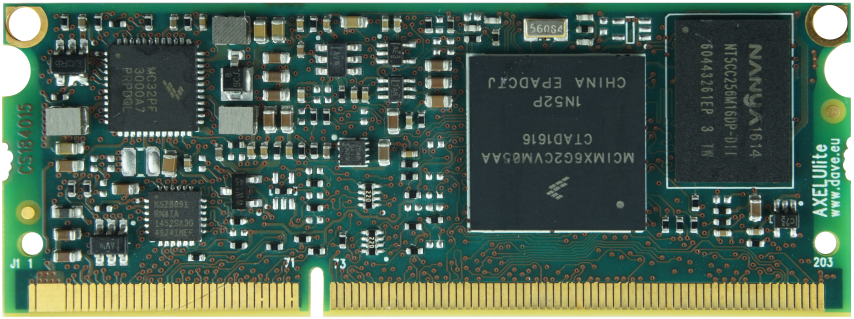
|
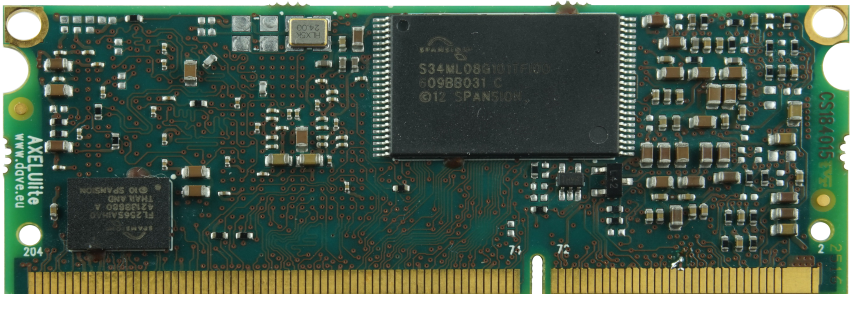
|
CPU |
NXP i.MX6 UL ARM Cortex A7 MPCore @ 528 MHz Base (-0), General Purpose (-1, -2), Security (-3) |
| Supervisor |
On-board power supply supervision Watchdog and RTC |
| Cache | L1: 32Kbyte instruction, 32Kbyte data L2: Unified data/instruction, 128 K |
| Memory |
|
| Interfaces (full-spec models) |
|
| Mechanical |
|
Power Supply |
Single 3.3V +/- 5%, on-board voltage regulation |
| Connectors and Pinout | ||
| Power and Reset | ||
| Peripherals |
|
|
| Electrical, Thermal and Mechanical Features | ||
|
|
||
|
|
||
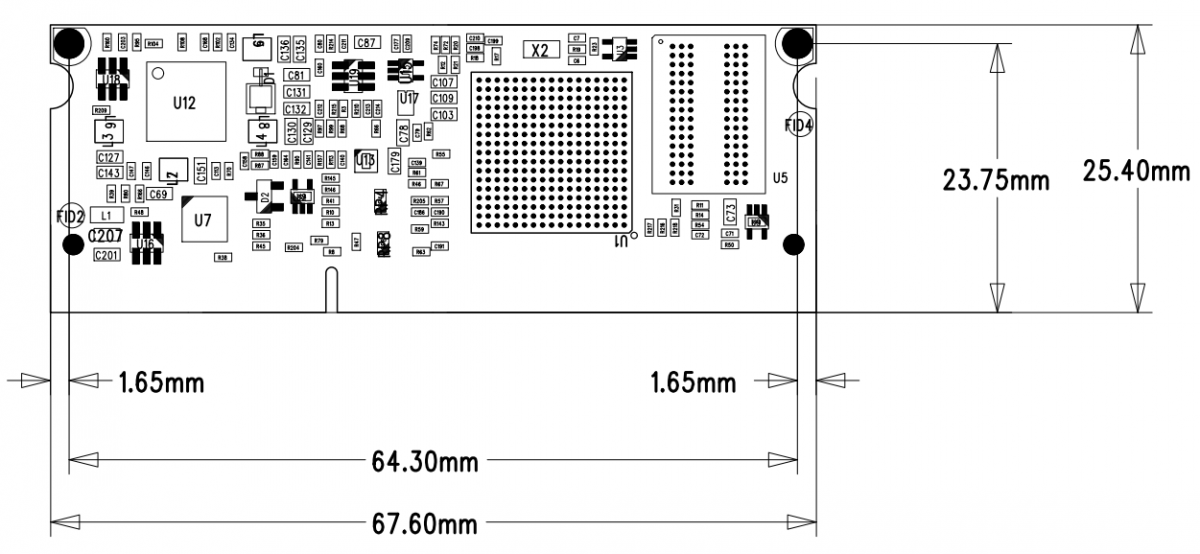
|
||
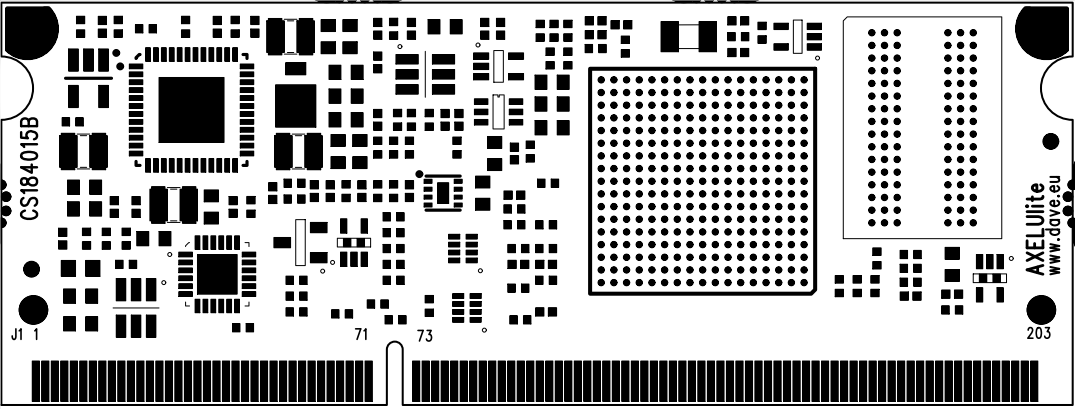
|
||
DAVE Embedded Software Kit Linux (DESK-MX6-L in short - read more info about the naming) - provides all the necessary components required to set up the developing environment to:
The Embedded Software kit is composed by:
Genereral Information |
|
Development |
|
Deployment |
|
Peripherals |
The official evaluation kit for AXEL ULite SOM. This solution includes a SOM and all necessary for the fast and easy evaluation
There are no PCN for AXEL ULite SOM

Yes, we have our Longevity Program based on Silicon Vendors' Longevity Program. For AXEL ULite see this page.
In this video, we explain how to check the longevity of DAVE Embedded Systems' products: DAVE Embedded Systems / HOW TO - How to check product Longevity

AXEL ULite is supported from DESK-MX6UL. The documentation is available on wiki. If needed, exist the PDF version

DAVE Embedded Systems strongly recommend to register your kit. Registration grants access to reserved material such as source code and additional documentation.
To register your kit, please send an email to helpdesk@dave.eu providing the kit P/N and S/N.

DESK-MX6UL-L is the Software Development Kit for AXEL Ulite SOM. Click here to download the DESK-MX6UL-L manual.
To download the technical documentation you will need to register on the DAVE Embedded Systems Wiki site. You can find the video tutorial with the guided procedure by clicking here: How to register to the DAVE Embedded Systems website.

DAVE Embedded Systems provides online technical and commercial information for all of its products. Once you reach the AXEL Ulite page on Wiki DAVE, we require a simple and fast registration access process to download the technical documentation.
In this video we explain how to do it: How to register to the DAVE Embedded Systems website.

On this page you will find the history of all versions of DESK-MX6UL-L (Software Development Kit for AXEL Ulite SOM) and the notes relating to each version.

On this page you will find the roadmap for all DAVE Embedded Systems products, with detailed release history of our SOMs and previews of future updates.

DESK-MX6UL-L contains all the required software and documentation to start developing Linux application on the AXEL ULite platform. In particular, DESK-MX6UL-L provides a virtual machine, called DVDK, with the following features:
/srv/tftp//etc/exports filePlease note that u-boot and kernel source trees are derived from the official trees released by NXP/Freescale; these trees have been customized to add support for the AXEL ULite SOM.
Click here for further information.

Yes. ConfigID is a new feature of DAVE Embedded Systems products. Its main purpose is providing an automatic mechanism for the identification of the product model and configuration. In simple words, model identification means the capability of reading a numerical code, stored in an available device (SOC's OTP , I2C EEPROM, 1-wire memories, protected NOR flash, etc.)
With ConfigID, we aim at completing the hardware configuration information that the software can't normally auto-detect (i.e. RAM chip version,...), implementing a dedicated reliable detect procedure and, when required, overriding the auto-detected hardware configuration information.
An additional attribute is UniqueID, which is a read-only code which univocally identifies a single product and is used for traceability.
For more information about DESK-MX6UL-L's ConfigID and UniqueID, see this page.

On this page you will find the detailed explanation on how to keep in sync and up to date the source trees with DAVE Embedded Systems' repositories.
Access to DAVE Embedded Systems' git repositories is granted to the development kit's owners only. Please refer to our video tutorial How to access DAVE Embedded Systems' git repositories for detailed instructions on how to get access.

See this page for further information on how to build the U-Boot bootloader with make on DESK-MX6UL-L (Software Development Kit for AXEL ULite SOM).

See this page for further information on how to build the Linux kernel with make on DESK-MX6UL-L (Software Development Kit for AXEL ULite SOM).
Please refer to our video tutorial How to add a new kernel device driver (build the kernel) for detailed instructions on how to do it.

See this page for further information on how to build the overall BSP with Yocto on DESK-MX6UL-L (Software Development Kit for AXEL ULite SOM).

See this page for further information on how to create a bootable microSD for DESK-MX6UL-L, the software development for AXEL ULite, by using a simple bash script.
Please refer to our video tutorial How to create the Evaluation Kit SD card for detailed instructions on how to create the Evaluation Kit SD card from scratch.

On wiki.dave.eu you can find an example on C code displaying the classic Hello World! message on the target serial console. This example shows how to use the arm cross-compiler using the environment configured for this purpose.

With respect to the NOR flash memories, NAND devices are known to be quite challenging with regard to the reliability. This is especially true when the NAND flash is used as the boot device. Several techniques such as wear leveling and bad block management have to be implemented to achieve an acceptable reliability.
This page provides information about the NAND device management, in order to handle it properly when it is used as the boot device on NXP i.MX6-based products.
Please refer to our video tutorial How to program U-Boot in NAND flash for detailed instructions on how to program and U-Boot on internal NAND flash.

On this page you can find further information on how to customize the splash screen on DESK-MX6UL-L (Software Development Kit for AXEL ULite SOM).
Please refer to our video tutorial How to change the U-Boot splash screen on SD card for detailed instructions on how to use your own company logo as a U-Boot splash screen.

You can download AXEL ULite SOM brochure by clicking here.
To download the technical documentation you will need to register on the DAVE Embedded Systems Wiki site. You can find the video tutorial with the guided procedure by clicking here: How to register to the DAVE Embedded Systems website.

On this page you can find how to program and configure a SOM to boot in standalone mode, without the need of a system microSD card or an NFS server.
The page contains general concepts that can be adapted on any DAVE Embedded Systems' Linux platform.
Please refer to our video tutorial How to program the NAND flash for a standalone boot for detailed instructions on how to do it.

For deploying an Embedded System, one of the most important configuration is the Network Interface configuration.
Once the Embedded Device is finally configured for stand-alone bootstrap, the network interface should be configured for reaching the device remotely via network connections like ssh, telnet, ftp, http, etc.
Visit this page for further information on how to simply configure the network interface on DESK-MX6UL-L (Software Development Kit for AXEL ULite SOM) or watch our tutorial How to configure the network interface.

If you’re interested in Axel ULite SOM contact us to get a quotation.


The AXEL ULite SOM product is based on the recent NXP Ultra Lite application processor.
The i.MX6UL processors feature NXP’s advanced implementation of the ARM® Cortex®-A7 MPCore, which operates at speeds up to 528MHz. These SOCs include a deep encryption and security capability, a complex and flexible boot management and an integrated power management.

AXEL ULite SOM is fully compatible with Axel Lite SOM. This enable customers to build a wide portfolio of products with very different performance, power consumption and cost budget.

The advanced security features and the three different CPU versions available (Base, General Purpose and Security) offer a wide scenario of applications. The i.MX6UL devices are able to serve a wide range of applications including:

Yes. AXEL ULite SOM Evaluation Kit includes a SOM and all necessary for the fast and easy evaluation.


The main features of this new product are:

On this page you can find AXEL ULite SOM 3D model.

On this page you can find AXEL ULite SOM’s block diagram.

On this page you can find AXEL ULite SOM’s hardware manual.
To download the technical documentation you will need to register on the DAVE Embedded Systems Wiki site. You can find the video tutorial with the guided procedure by clicking here: How to register to the DAVE Embedded Systems website.

Here you can find all the AXEL ULite SOM’s marketing documentation available.

AXEL ULite SOM module part number is identified by the digit-code table that you can find here.

DAVE Embedded Systems' goal is to grant the production continuity to its customer including the possibility to redesign its products in order to maintain the product continuity.

If you want to request support to our technical team please fill this form. After the submission, a ticket will be assigned. Our technicians will look after your request and respond you via email within 24 hours.
DAVE Embedded Systems provides a very efficient technical support via a helpdesk ticketing system. In this video we show you all the ways you can get help from us: How to contact DAVE technical support.

Here you can find the DAVE Embedded Systems' Return Material Authorization form.

Yes. You can download the AXEL ULite SOM's hardware manual by clicking here.
To download the technical documentation you will need to register on the DAVE Embedded Systems Wiki site. You can find the video tutorial with the guided procedure by clicking here: How to register to the DAVE Embedded Systems website.

AXEL ULite SOM’s processor and memory subsystem are composed by the following components:

Yes. The PCB version is copper printed on PCB itself and the serial number is printed on a white label (please see here for further information). Also, a ConfigID is used by software running on the board for the identification of the product model/hardware configuration.
Click here to see in what areas AXEL ULite SOM ConfigID is stored.

Here you can find the connectors and pinout description of the AXEL ULite SOM.


AXEL ULite system-on-module (SOM for short) is powered by carrier board via VIN_SOM rail. About voltage range, three supported configurations are available: click here for more details.
Implementing correct power-up sequence for i.MX6UL processors is not a trivial task because several power rails are involved. AXEL ULite SOM simplifies this task by embedding all the needed circuitry. Here you can find a simplified block diagram of PSU/voltage monitoring circuitry.
The PSU is composed of two main blocks: 1) power management integrated circuit (PMIC NXP PF3000) 2) that completes PMIC functionalities.
The PSU generates the proper power-up sequence required by i.MX6UL processor, surrounding memories and peripherals and synchronizes the powering up of carrier board in order to prevent back power.
The typical power-up sequence is the following:

NXP iMX6UL processor implements a very flexible boot process. This versatility comes at the price of a non trivial bootstrap configuration scheme. Typical system-on-module (SOM for short) adopter does not need to deal with such a complexity. In other words, he/she expects to manage few boot configuration issues because it is assumed that most of them are "hidden" within the SOM itself. Nevertheless, there are specific applications where the system integrator needs full control of all the bootstrap configuration options, even if the design is built upon a SOM.
For further information about AXEL ULite SOM’s boot options, please check out more by clicking here.

Here you can find a block diagram of reset scheme and voltage monitoring.

TAG recovery, though very useful (especially in development or production environment), requires dedicated hardware and software tools. AXEL ULite provides an internal connector for the JTAG interface, which, besides the debug purpose, can be used for programming and recovery operations.
For further information on how to use the JTAG interface, please contact the Technical Support Team.

The AXEL ULite SOM is designed to support the maximum available temperature range declared by the manufacturer. The customer shall define and conduct a reasonable number of tests and verification in order to qualify the DUT capabilities to manage the heat dissipation. Any heatsink, fan etc shall be defined case by case.
DAVE Embedded Systems' team is available for any additional information, please contact sales@dave.eu or check this page for further information.

Here you can find the mechanical characteristics of the AXEL ULite SOM.

Yes. DAVE Embedded Software Kit Linux (DESK-MX6UL-L in short) provides all the necessary components required to set up the developing environment to:
Click here for further information about DESK-MX6UL-L.
Welcome to the DAVE Embedded Systems' technical information form submission portal!
Please fill in the fields below. The support team will take care of you in maximum 24h!
Welcome to the DAVE Embedded Systems' Documentation system. Please fill in with required information and you will get your document! Thank you!.
We use cookies to personalize content, to get traffic statistics and to improve your experience on our website.
Please read our Cookie Policy for a more detailed description and click on the "Manage preferences" button to customize how the site uses cookies for you. By clicking on "Accept all cookies" you give your consent for the use of each type of cookie.
These cookies are necessary for the website to function and cannot be switched off in our systems.
You can set your browser to block or alert you about these cookies, but some parts of the site will not then work. These cookies do not store any personally identifiable information.
These cookies allow us to count visits and traffic sources so we can measure and improve the performance of our site. They help us to know which pages are the most and least popular and see how visitors move around the site.
All information these cookies collect is aggregated and therefore anonymous. If you do not allow these cookies we will not know when you have visited our site, and will not be able to monitor its performance.
Select all Deselect all